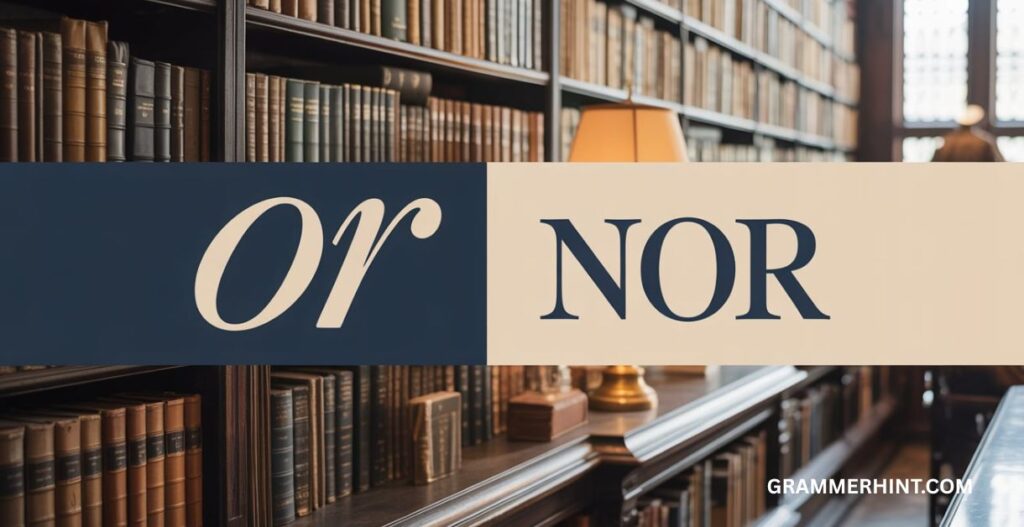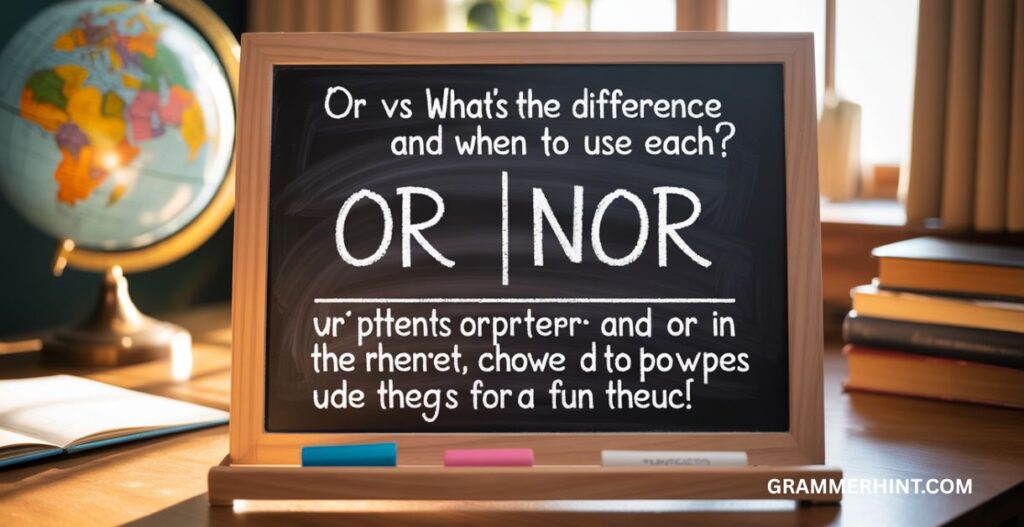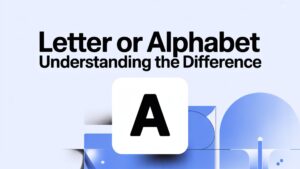Millions of writers trip over “nor vs or.” Understanding the difference between nor and or can sharpen your writing clarity and guide readers through your logic smoothly.
Let’s explore their paths from conjunction origins and history to grammar rules for or and nor, followed by plenty of usage examples of or and nor and practical professional writing tips.
1. Conjunction Origins and History
English borrowed “or” from Old English oþþe, signaling choices and possibilities. “Nor” comes from Old Norse né plus or, firmly linking negative constructions. Over centuries, “or” stayed a beacon of alternatives; “nor” became the preferred linking negative statements tool when rejecting one or more options.
2. Grammar Rules for Or and Nor

2.1 Or
- Signals choices and possibilities: “Would you like tea or coffee?”
- Works in conditional statements: “Study hard or you’ll fail.”
- Great for presenting options clearly—and for logical alternatives.
2.2 Nor
- Joins two negatives: “She doesn’t play tennis nor does she swim.”
- Often follows “neither…”: “Neither…nor” pairs nicely: “Neither Alex nor Jordan attended.”
- Think of it as another “and not.”
- Supports negative outcomes in sentences: “The plan didn’t succeed nor bring any benefit.”
2.3 Or vs Nor → Conjunction Differences Summary
| Conjunction | Use Functions | Example |
|---|---|---|
| Or | Present logical alternatives, choices, conditional statements | “Select A or B.” |
| Nor | Link negative constructions, especially after “neither…” | “Neither Anna nor Ben answered.” |
3. Scenario Examples (Emails, Notes & Conversations)
3.1 Email Example – Professional Writing Tips
Subject: Meeting Reminder – Action Items
Hi Jordan,
Hope you’re well. Please let me know whether you’d like a Zoom or in‑person meeting. Or vs nor matters here to keep communication sharp.
Also, neither…nor example: “We have neither confirmed the date nor the agenda,” so kindly advise.
Best,
Alex
Notes:
- Or helps present choices and possibilities.
- Neither…nor and nor link negative statements clearly. A colleague reading that gets clear context—no confusion.
3.2 Casual Conversation
“Do you want pizza or burgers tonight?”
“I’m not in the mood for Italian nor fast food—I’ll cook at home.”
Here, or gives choice. Nor handles two negative rejections.
3.3 Memo in Business Writing
TO: Team
RE: Project Roadblock
We haven’t resolved the bugs nor fixed the UI glitch. We must address both issues before launch. Let’s discuss if we’ll add features or polish the existing ones.
Notes:
- Nor links negative outcomes (“haven’t resolved… nor fixed…”).
- Or presents logical alternatives (“add features or polish”).
3.4 Newsletter or Blog Post
“You might feel stuck choosing between writing in formal or informal tone. Choosing incorrectly can harm clarity. Avoid starting sentences with “And” or “But” for a more polished style. And if you thought that passive voice is okay, think again—it leads to muddy meaning nor crisp impact.”
This shows how or vs nor difference clarifies tone choices and negative context. It also touches on common mistakes with or and nor by warning against passive voice.
4. Common Grammatical Mistakes with Or and Nor
- Using “nor” when you mean “or.”
Wrong: “Would you like tea nor coffee?”
Correct: “tea or coffee.” - Forgetting neither before nor.
Wrong: “I want nor this nor that.”
Correct: “I want neither this nor that.” - Overusing “or” in double negatives.
Confusing: “Don’t call or email unless it’s urgent.” (Is it a choice or a condition?)
Clarify: “Don’t call or email unless it’s urgent,” or “Call or email only if it’s urgent.” - Ignoring sentence inversion after “nor”.
Compare:- “She doesn’t dance nor does she sing.” (Correct inversion.)
- “She doesn’t dance nor she sings.” (Incorrect.)
5. Conjunction Usage in Writing Clarity
5.1 Linking Negative Statements
Use nor when you’ve already negated something and want to add another negative. The structure often inverts verb and subject:
- “I didn’t like the movie, nor did I enjoy the soundtrack.”
- If you skip inversion, sentences sound clunky or wrong.
5.2 Presenting Options with “Or”
Or shines when offering readers choices and possibilities. It supports clear communication and writing clarity:
- “We can outsource or handle development in-house.”
- “You can upgrade your plan or stick with the basic one.”
5.3 Sentence Structure Inversion
After “nor,” we invert:
- Normal: “I don’t swim.”
- Add another: “Nor do I run.”
- Two negatives: “I don’t swim nor run.”
5.4 Negative Comparisons & Avoiding Redundancy
Compare these:
- Redundant: “I didn’t go to the meeting, nor did I not send an update.”
- Better: “I didn’t go to the meeting nor send an update.”
You cut wordiness and avoid redundancy, making writing sharper.
6. Alternates vs Exclusions: Alternatives vs Exclusions with Or and Nor
Another way to think of it: Or equals alternatives. Nor delivers exclusions.
- Alternatives (Or): “We can travel by car or train.”
- Exclusions (Nor): “I want neither the car nor the train.”
In logical terms, you offer paths with or, block paths with nor. That’s the crux of the or vs nor conversation—or rather nor vs or.
7. More Usage Examples of Or and Nor
Let’s practice with a few quick hits:
- Conditional statements
“Speak up or you’ll miss the chance.” - Negative conjunctions
“He can’t sing nor dance.” - Neither…nor
“Neither rain nor snow will stop open-air concerts.” - Choices and possibilities
“Bring a pen or a pencil.” - Negative outcomes in sentences
“The effort didn’t pay off nor improve our score.” - Sentence connectors
“I skipped the test, nor did I review the material.” - Conditional with nor (rare but used for emphasis)
“Don’t blink, nor look away.”
You see how each tool fits a niche.
8. Professional Writing Tips for Using Or and Nor

- Always pick the conjunction that matches your intent—choices or exclusions.
- Use neither…nor for symmetry in negative constructions.
- Keep inversion after nor: a verb-first structure adds polish.
- Avoid stacking negatives with or—it invites confusion.
Tip: When in doubt, rephrase. Instead of “I don’t want A nor B,” try “I want neither A nor B.” That shift locks in clarity.
9. Enhancing Clarity with Sentence Emphasis Techniques
Or can emphasize: “Act now or regret it later.”
Nor can deepen negativity: “He didn’t apologize. Nor did he mean to.”
A subtle sentence connector or reposition can sharpen focus:
- Before: “She didn’t read. Nor did she write.”
- After: “She didn’t read; nor did she write.”
Or break it into two sentences: “She didn’t read. Nor did she write.” It sounds punchier.
10. Formal vs Informal Tone
Formal Tone:
“In the event that the files are unavailable, clients may submit an alternative or contact support. Neither system access nor customer data shall be affected.”
Informal Tone:
“If the files don’t show up, you can try another link or just reach out. And hey, neither of the systems nor your data should be messed up.”
You match the tone to context—formal vs informal tone matters especially in business settings.
11. Sentence Structure Inversion After Nor
This deserves its own spotlight. When “nor” links two negatives, invert:
- “She doesn’t eat meat, nor does she drink alcohol.”
- Incorrect: “She doesn’t eat meat nor she drink alcohol.”
Inversion keeps rhythm and clarity. Without it, writing feels off-balance.
12. Language Precision and Clarity in Writing
Using or vs nor correctly shows attention to detail and helps avoid common grammatical mistakes. It enhances language precision. When readers see “or,” they expect options. When they see “nor,” they brace for exclusion or continuation of a negative.
Writers who master this avoid confusion, strengthen arguments, and produce cleaner, more convincing prose.
13. Final Notes on Nor vs Or
Let’s recap with a little analogy:
Imagine “or” as a fork in the road a choice between routes. You can go left or right.
Think of “nor” as a barricade on both paths: “Neither this road nor that one is open.”
You’ve just seen how to use these conjunctions in everyday language, professional notes, and creative writing. You’ve learned about conditional statements, negative constructions, sentence connectors, negations, and more. You’ve also picked up on sentence emphasis techniques, negative context, and how to avoid common mistakes with or and nor.









